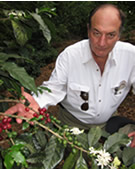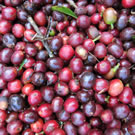Partners Helena Wright (UK), Annie Wallace (US) and Stephen Oluoch (Kenya) have been developing a project over the past six months on the Kenyan coast near Mombasa with a community of fishermen and subsistence farmers.
| Indigenous Knowledge | |
 |
The process began with a participatory needs assessment with community members and has continued with a series of community meetings as the project has developed. |
Last week, Stephen met again with the community to gain a better understanding of their knowledge of climate change, challenges that they are experiencing attributable to climate change, and activities that they have begun on their own using indigenous knowledge to adapt to their changing situation.
The results of the meeting were summarized in vulnerability matrices identifying hazards and livelihood challenges the community faces in the light of a changing climate.
Vulnerability Matrix 1: What is a prioritization of the community’s greatest hazards they face?
- Unpredictable rainfall during the rainy season makes it difficult for farmers to plan cropping
- Drought has caused livestock deaths and crop failures or low crop yields
- Intense sunshine coupled with decreased rainfall causes crops to wilt or ripen early (coconut, banana, and cashew nut)
- High temperatures causes people to sleep out in the open or with windows opened which increases malaria incidences
- Unusually heavy rainfall causes pit latrines to overflow and contaminate drinking water increasing diarrhea
- Shortage of household water
Vulnerability Matrix 2: What parts of their lives (livelihood resources) are the most vulnerable?
- Income-livelihood security
- Health & Nutrition
- Water resources
- Food security
| Marry Scientific Knowledge to Indigenous Knowledge |
|
 |
On their own, the community members have come up with coping strategies which include crop substitution for more drought tolerant crops. However, without scientific knowledge supporting their decisions several of their coping strategies are not sustainable. For example, the substitution of water intensive corn for drought tolerant cassava robs the family of a major source of income. |
Adaptation to Climate Change:
The community members realize that water shortages and changing weather patterns are a major threat to their survival and believe that coupling their indigenous coping strategies with sound agricultural extension can create a winning solution.
Here is a simple project outline that Helena, Annie, and Stephen have developed with the community to adapt to their climate change related agricultural challenges.
Community-Based Adaptation program related to climate change:
[Problem]. Climate variability, extreme weather, and unpredictable rainy season have reduced crop harvests
Farmer Soil Conservation, and Water Conservation and Management Program
[Activity 1]. Farmer workshop on soil restoration and conservation techniques
[Activity 2]. Farmer workshop on water conservation and management techniques
Farmer Extension Program
[Activity 1]. Farmer workshop and follow-up on early maturing and/or drought resistant crops/varieties for adapting to climate variability
[Activity 2]. Farmer workshop and follow-up on buffering against the late arrival of rain and/or an early end to the rainy season
Stevens NGO, Coastal Oceans Research and Development in the Indian Ocean (CORDIO) was started in 1999 in direct response to the El-Niño related mass bleaching of coral in the Indian Ocean in 1998. CORDIO goals are to conduct research on coastal and ocean ecosystems relevant to conserving, sustaining and restoring healthy and productive marine environments, and to participate in poverty alleviation and sustainable development.
Would you like to learn how to develop Community Based Adaptation Projects?
Please write us with your stories, thoughts and comments through Online.Learning@csd-i.org



